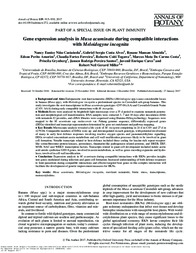Gene expression analysis in Musa acuminata during compatible interactions with Meloidogyne incognita.
Gene expression analysis in Musa acuminata during compatible interactions with Meloidogyne incognita.
Author(s): CASTAÑEDA, N. E. N.; ALVES, G. S. C.; ALMEIDA, R. M.; AMORIM, E. P.; FERREIRA, C. F.; TOGAWA, R. C.; COSTA, M. M. do C.; GRYNBERG, P.; SANTOS, J. R. P.; CARES, J. E.; MILLER, R. N. G.
Summary: Background and Aims: Endoparasitic root-knot nematodes (RKNs) ( Meloidogyne spp.) cause considerable losses in banana ( Musa spp.), with Meloidogyne incognita a predominant species in Cavendish sub-group bananas. This study investigates the root transcriptome in Musa acuminata genotypes 4297-06 (AA) and Cavendish Grande Naine (CAV; AAA) during early compatible interactions with M. incognita . Methods: Roots were analysed by brightfield light microscopy over a 35 d period to examine nematode penetration and morphological cell transformation. RNA samples were extracted 3, 7 and 10 days after inoculation (DAI) with nematode J2 juveniles, and cDNA libraries were sequenced using lllumina HiSeq technology. Sequences were mapped to the M. acuminata ssp. malaccensis var. Pahang genome sequence, differentially expressed genes (DEGs) identified and transcript representation determined by gene set enrichment and pathway mapping. Key Results: Microscopic analysis revealed a life cycle of M. incognita completing in 24 d in CAV and 27 d in 4279-06. Comparable numbers of DEGs were up- and downregulated in each genotype, with potential involvement of many in early host defence responses involving reactive oxygen species and jasmonate/ethylene signalling. DEGs revealed concomitant auxin metabolism and cell wall modification processes likely to be involved in giant cell formation. Notable transcripts related to host defence included those coding for leucine-rich repeat receptor-like serine/threonine-protein kinases, peroxidases, thaumatin-like pathogenesis-related proteins, and DREB, ERF, MYB, NAC and WRKY transcription factors. Transcripts related to giant cell development included indole acetic acid-amido synthetase GH3.8 genes, involved in auxin metabolism, as well as genes encoding expansins and hydrolases, involved in cell wall modification. Conclusions: Expression analysis in M. acuminata during compatible interactions with RKNs provides insights into genes modulated during infection and giant cell formation. Increased understanding of both defence responses to limit parasitism during compatible interactions and effector-targeted host genes in this complex interaction will facilitate the development of genetic improvement measures for RKNs.
Publication year: 2017
Types of publication: Journal article
Unit: Embrapa Cassava & Fruits
Observation
Some of Embrapa's publications are published as ePub files. To read them, use or download one of the following free software options to your computer or mobile device. Android: Google Play Books; IOS: iBooks; Windows and Linux: Calibre.
Access other publications
Access the Agricultural Research Database (BDPA) to consult Embrapa's full library collection and records.
Visit Embrapa Bookstore to purchase books and other publications sold by Embrapa.

